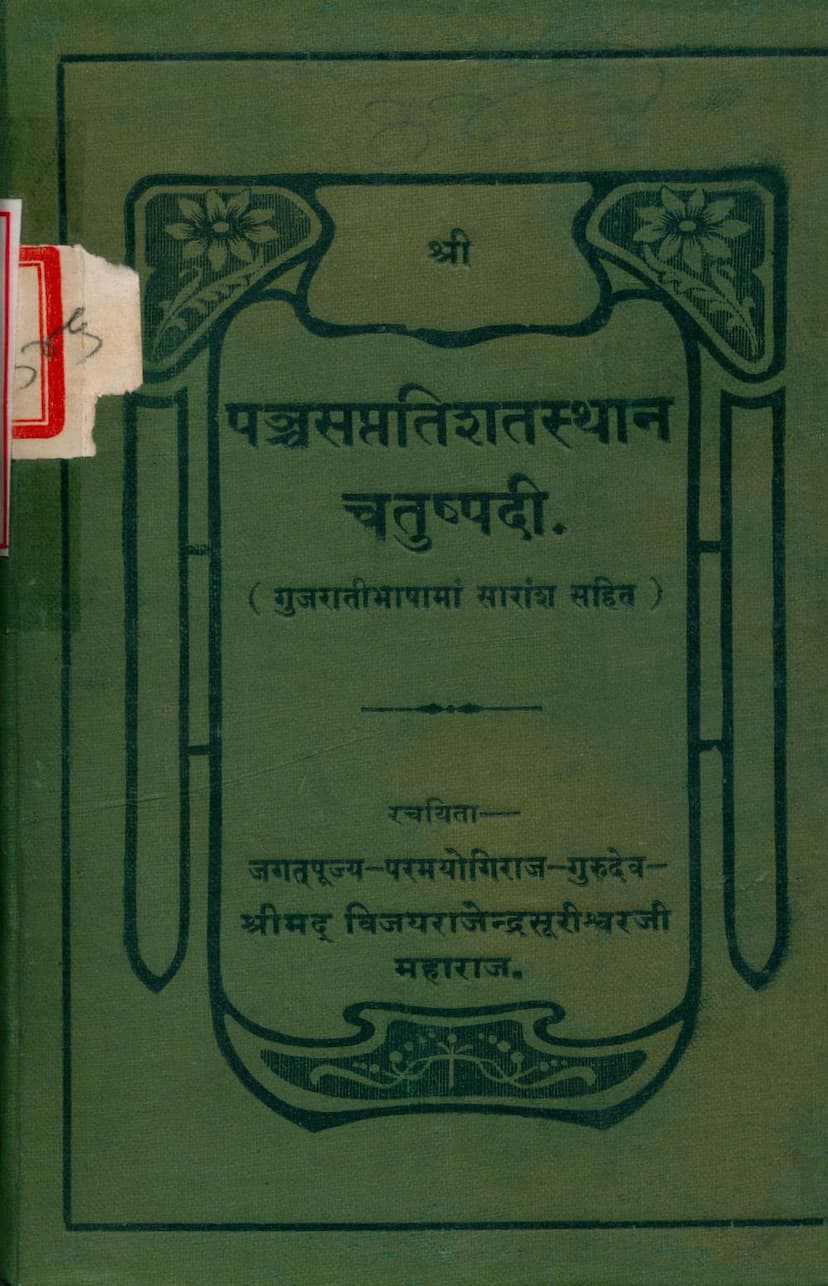Panchsaptati Shatsthan Chatushpadi
Added to library: September 2, 2025

Summary
Here's a comprehensive summary of the Jain text "Panchsaptati Shatsthan Chatushpadi" based on the provided pages:
Book Title: Panchsaptati Shatsthan Chatushpadi (Seven Hundred and Seventy-Four Verses/Stanzas) Author: Paramayogi Raj Gurudev Shrimad Vijay Rajendrasurishwarji Maharaj Compiler/Commentator: Upadhyay Muni Shriyateendravijayji Maharaj Publisher: Sh. Ratan Chand Hajarimal Kasturchandji Porwad Jain
Overall Purpose and Content:
The "Panchsaptati Shatsthan Chatushpadi" is a detailed Jain scripture that systematically enumerates 175 important "places" or aspects related to the lives, teachings, and spiritual journeys of the 24 Tirthankaras (Jinas) of the current era. It also includes 12 key aspects related to the 20 Vihareman (currently living) Tirthankaras. The book aims to provide comprehensive knowledge about the Jinas, making it accessible and beneficial for all Jains to study and learn.
Key Features and Structure:
-
Comprehensive Data: The text meticulously details numerous aspects of the Jinas' lives, from their past lives and the circumstances of their conception and birth to their renunciations, enlightenment, teachings, and eventual liberation (moksha).
-
Categorization (Ullasa - Chapters): The information is organized into six main sections or "Ullasa" (chapters), each covering a specific range of the 175 "places" (sthan):
- Pratham Ullasa (Places 1-20): Covers aspects like the number of past lives of each Tirthankara, details of their past lives (continents, regions, cities, gurus, etc.), the reasons for acquiring their Tirthankara name, and details of their mothers' dreams and their interpretation.
- Dwitiya Ullasa (Places 21-55): Focuses on birth details (month, date, time, constellations, zodiac signs), lineage, the qualities of their birth, the number of Indra and their actions, lineage and clans, names and their meanings, physical characteristics (symbols, number of hoods, complexion, strength, height), and their lifespan as householders and ascetics.
- Tritiya Ullasa (Places 56-98): Discusses marriage (or lack thereof), reign periods, number of offspring, the arrival of Lokantik deities, annual charity, details of renunciation (month, date, constellations, age, ascetic practices), the palanquin of renunciation, family of renunciation, renunciation city, time of enlightenment, tree, forest, and ritual tonsuring (lonch), celestial garments, the first meal offering, the first alms-givers, spiritual practices, and the duration of their life as an ascetic before enlightenment.
- Chaturtha Ullasa (Places 99-145): Covers the Tirthankaras' impeccability, the 34 types of perfections (atishay), the 35 perfections of their divine speech (jinwani), the 8 types of auspicious emblems (pratiharyas), the establishment of their respective religious orders, the lineage of their chief disciples (ganadharas) and female disciples (sadhvis), the names of prominent devotees and patrons, the presiding Yakshas and Yakshinis, and the numbers of their disciples (monks, nuns, enlightened ones, etc.), their divine orders, and their ascetic practices.
- Pancham Ullasa (Places 146-175): Details the duration of their lives as householders and enlightened beings, their lifespan as ascetics, their total lifespan, details of their liberation (month, date, constellations, zodiac signs, location, posture, height, and ascetic practices at the time of liberation), their retinue at liberation, the time of liberation, and the period of their influence. It also touches upon the continuity of their lineage and the intervals between Tirthankaras, notable figures associated with their teachings, miraculous events, and the spread of different philosophical schools and the types of rulers and heroes who appeared during their times.
- Shashth Ullasa (Places 1-12): Specifically focuses on the 20 Vihareman Tirthankaras, providing their names, mothers' names, fathers' names, wives' names, symbols, regions of their disciples, cities of birth, and physical characteristics like complexion, age, and height.
-
Inspiration and Methodology: The work is inspired by earlier Jain texts, particularly the "Sattarisayathana Prakaran" (Seventy-Place Treatise) by Somatilak Suri, but the author has added five more aspects based on other Jain scriptures.
-
Gujarati Summary: The book includes a summary in Gujarati, which makes it easier to understand for those familiar with the language.
-
Poetic and Metered Structure: The content is presented in various poetic meters (like Dohas, Chaupais, Sorathas, Harigeet) which adds to its devotional and learning appeal.
-
Inclusion of "Mahavir-Gautam Pravachan": At the end of the book, there is a section titled "Mahavir-Gautam Pravachan," which is a dialogue between Lord Mahavir and his chief disciple Gautam Swami. This section explains the karmic consequences of various actions, illustrating how specific deeds in past lives lead to certain physical or social characteristics in the present life (e.g., blindness, deafness, deformities, social status). This serves as a moral and ethical guide, emphasizing the principle of karma.
Significance:
This text is a valuable resource for understanding the detailed biographical and spiritual aspects of all 24 Tirthankaras. It serves as a comprehensive guide for Jain scholars and devotees, offering insights into the lives and teachings that form the foundation of Jainism. The author's effort in compiling such extensive information from various sources makes this a significant contribution to Jain literature.